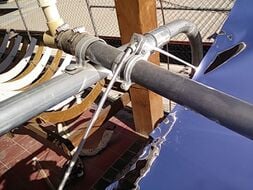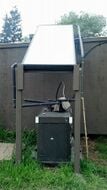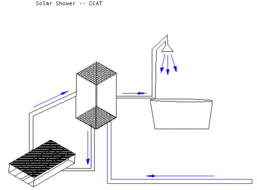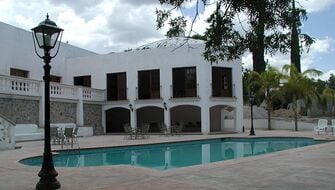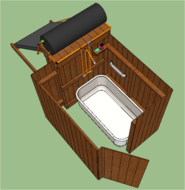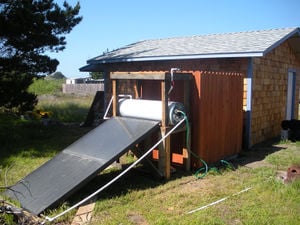
This spring 2011 semester, we constructed a passive thermosyphon solar shower system that utilizes natural temperature stratification to heat and store water without natural gas or electricity. Constructed at the Manila Eco-Hostel, this is an educational piece that seeks to inspire travelers of the area to recreate such a project in their own community.
Background[edit | edit source]
Continuing on the design for the Samoa Hostel Thermosyphon Solar Shower System, designed by previous Engineering 215 students at Cal Poly Humboldt, we have constructed a solar shower at the Manila Eco Hostel. This shower uses a solar water heating panel to heat water for an outdoor, enclosed shower, providing visitors with an aesthetically pleasing, functioning way to shower sustainably.
Opportunity Definition[edit | edit source]
The objective is to demonstrate, educate, and inspire an alternative way of heating water to visitors of the eco-hostel.
Solar Water Heating Basics[edit | edit source]
Solar water heating is a growing and innovative field that takes advantage of the suns energy to heat water.[1][2] Solar water heating is a growing market, as Israel, China, Australia, and Austria continue to expand the field.
Types Solar Water Heating[edit | edit source]
Generally there are two types of solar water heating: passive, and active[3] heating.
Passive Solar Water Heating[edit | edit source]
- Integrated Collective Storage: This simple and relatively cheap design is a storage tank that also collects heat from the sun. The disadvantage of this tank is that it needs to be in a hot climate for it to be effective.[4]
- Convection Heat Storage Unit: Using the properties of convection and thermosyphoning, this system uses a solar water heater panel to collect heat and move water against gravity into an insulated water tank.[5][6]
Active Solar Water Heating[edit | edit source]
Active solar water heating systems use electricity to pump fluid from the panel to the storage tank.[7] The advantage of an active solar water heating system is that it has the capability to run at higher efficiency with the installation of a pump and controller.[8] These items allow the water to be circulated faster, allows for storing the water tank lower than the panel, and also reduces the risks of overheating from increased circulation. There are three classifications for Active Solar Water Heating systems:[9][10]
Direct System[edit | edit source]
Water is the medium which is heated up in a solar collector and is then actively pumped into an insulated storage tank. Concern for freezing should be considered in places with seasonal cold climates.
Indirect System[edit | edit source]
Anti-freeze circulates through the solar collector, collecting heat. The Anti-freeze is then circulated through a heat exchange device to transfer the heat to water without mixing. This system is a good alternative to the Direct System if freezing is a concern.
Drain-Back System[edit | edit source]
Similar to that of the Indirect system, except the Drain-back system allows for fluid to drain out of the solar collector when not in use, which allows for variation in design from the Indirect System. This is also a good candidate for cold weather climates.
Implementation Cost[edit | edit source]
The materials needed for this specific project are listed below. Included is the item name, the quantity needed, the cost per unit item, the cost at which we received the item (at the quantity needed), and an estimated retail cost should someone care to build a system modeled after this page. Several items have been donated and others have been previously obtained by another group working on this project. Items that are labeled NA are items that were not required for the testing phase we concluded with, but would be needed for a lasting final result. The variability for the final cost is due to the large range of price a solar water heating panel can have and it should be noted that our range is a modest one.
| Materials | Quantity | Unit Cost($) | Actual Cost ($) | Retail Cost ($) |
|---|---|---|---|---|
| 2x4 (8 feet) pressure treated | 8 | $3.79 | $30.32 | $30.32 |
| 4x4 (8 feet) pressure treated | 5 | $8.96 | $44.80 | $44.80 |
| Redwood Fence Boards | 56 | $3.25 | donated | $182.00 |
| Concrete | cubic yard | 1 | $130.00 | $130.00 |
| Fencecrete | 5 | $3.99 | $19.95 | $19.95 |
| Thompson's Water Sealer | 2 | $15.99 | $31.98 | $31.98 |
| Latch | 1 | $1.99 | $1.99 | $1.99 |
| Hinges | 2 | $2.99 | $5.98 | $5.98 |
| Shower Head | 1 | $12.99 | $12.99 | $12.99 |
| 2.5" Screws | 5 lbs | $2.99 per lbs | $14.95 | $14.95 |
| Shower Pan Drain | 1 | $9.99 | $9.99 | $9.99 |
| Hot Water Heater | 1 | $80.00 | donated | $80.00 |
| Copper Pipe (feet) | 30 | $3.00 | NA | $90.00 |
| Solar Water Heating Panel | 1 | $500-1,000 | donated | $1,000 |
| Total Cost | $302.95 | $1654.95 | ||
Evaluation Criteria[edit | edit source]
This section includes all possible aspects thought up by the group members for this project as well as the partners of the Manila Eco-hostel. These criteria were chosen to evaluate the project based on ease of use, educational capacity, and aesthetic. These criteria helped us to determine how much time, money, and effort should be invested in each aspect of the system based on its importance to our clients.
| Criteria | Constraints | Our weight (0-10) |
|---|---|---|
| Maintainability | Must be able to maintain functionality on less then.5 human labor hrs a week. | 7 |
| Safety | Must be able to function with out possible injury to users or observers. | 9 |
| Effectiveness | Must be able to power a device for the full duration of its intended function. | 8 |
| Ease of use | Must be usable for adults without struggle. | 7 |
| Social justice | 50 % of materials must be donated or reused. | 5 |
| Educational value | Must be able to provide an understanding of the functionality and use of the device, within a two minute viewing span. | 9 |
| Aesthetics | Must be pleasing to the eye and look professional. | 6 |
Proposed time line[edit | edit source]
| Week: | Tasks: |
|---|---|
| Week 6 (3/7/11) | Collect Materials: Fencing Meeting with "Truth Window" Team to Confirm Measurements Meeting with "Water Boys" Team to confirm measurements Confirm Measurements |
| Week 7 (3/14/11) | Survey Job Site Data Collection: Solar Pathfinder |
| Week 8 (3/21/11) | Solidify Design: Shower Confirm Measurements Create Project Site Map |
| Week 9 (3/28/11) | Construction Assembly Create Signage for thanking donaters |
| Week 10 (4/4/11) | Construction Assembly Timesheet #5 Due 4/8 |
| Week 11 (4/11/11) | Construction Transport Shower, Install Shower Start Final Draft Project Report |
| Week 12 (4/18/11) | Construction Transport Greywater, install greywater Work on FDPR |
| Week 13 (4/25/11) | Testing, adjustments to System Work on FDPR |
| Week 14 (5/2/11) | Testing, adjustments to System Work on FDPR |
| Week 15 (5/9/11) | Turn in FDPR |
Procedure[edit | edit source]
This section will discuss how we selected the location for the solar shower, the general methods of our construction, and our sampling techniques.
Optimal Sun and Privacy[edit | edit source]
The first step is to identify the location on site that will provide the best light while also providing natural cover from public view. Using a solar pathfinder, charts are made to determine the amount of sun available for every month throughout the year. Since the most important months are during the summer when the Manila eco-hostel will expect the most visitors and the best sun exposure, we ensure that those month's hours of sunlight are unhindered by surrounding structures. There also needs to be enough space to lay the solar panel close to the shower enclosure while still facing south (since it is located in the northern hemisphere). The next condition is that some amount of elevation is required relative to the rest of the area so that a greywater treatment system can be installed in the future and will have enough head.
Construction[edit | edit source]
The first step is to stake out the area that will be occupied by the shower and take measurements. The first digging done is for the 4x4" (8ft long) pressure treated fence posts. Five holes are dug (4 corner posts and a post for the door) at a depth of two feet. The posts are then placed in their holes and kept level (with a level). Fencecrete is then added and left to dry overnight. While the posts are setting,the area for the concrete shower pad can be excavated. Digging 8" deep around the perimeter and 6" deep at the center, the concrete will form a natural anchor. At the same time, a trench is dug where the waste water will exit the shower. Care is taken to be sure there is enough head for ample draining (roughly a 1/4" drop per 1' length). Because we anticipate buying a cubic yard of concrete, we calculate the volume so that the amount will be sufficient. Before laying the concrete, we first build the forms along the fence posts. Then we pour the concrete with the drain in place and smooth it out with a gradient leading toward the drain. The last step is treating and laying the redwood fence boards along parallel 4x2" pressure treated beams connected to the fence posts.
Methods for Testing[edit | edit source]
Using a thermometer, temperature of the water going into the system, the water leaving the panel, and the resulting temperature from the shower-head can be measured.
Gallery[edit | edit source]
-
Designing project layout
-
Setting up posts in fencecrete
-
Posts with concrete
-
Max starting the fencing process
-
Fencing complete
-
Fencing with nice redwood stain
-
Robbie next to fencing with door
-
Constructed bench
-
Robbie utilizing the bench
-
Final product
-
Final Product
Results[edit | edit source]
On a warm 21°C day with full sun in Manila, we managed to heat 15°C water to 47°C as measured from the output of the panel. After 10 minutes, the water coming from the shower head was 20°C, but did not heat significantly more after 50 minutes. Ideally, this system will have several hours to heat and allow for temperature stratification in the water heater tank and the tank will be better insulated then it was during our tests.
Next Steps[edit | edit source]
Over the summer of 2011, a cradle will be constructed at the crest of the north side of the shed roof to house and insulate an electric water heater tank. Also, the solar water heater panel will be fastened to the south side of the shed roof and the permanent plumbing will be installed. After that is done, the Samoa Hostel Truth Tank could be connected for natural grey water treatment and education on grey water treatment.
Conclusion[edit | edit source]
The final product of this project ultimately varied quiet a bit from our original design. Discrepancies between our team and other representatives of the eco-hostile ultimately were settled with this final result. The major compromise was between using a claw foot bathtub and laying down a concrete shower pad. Ultimately the concrete shower pad makes the shower more accessible and safe while the claw foot bathtub could have posed as a liability. Had we more time to work out the conflict of interest between "appropriateness" and safety, perhaps we could have still used the claw foot bathtub with a different design, but because time and money were a limiting factor, I think the decisions we made were optimal. Another discrepancy that I wish we could have dealt with sooner was between using a gas and electric tank. If we had more time, perhaps we could have acquired the proper tank and installed it so that the project could be left in a more complete stage. Luckily, an electric tank will be arriving soon and our project will be continued. What we have certainly learned through this experience is the importance of communication between all affiliates of a non-profit project such as this.
Related projects[edit | edit source]
References[edit | edit source]
- ↑ Patterson, J. (2010). "Solar Hot Water Basics." Homepower Magazine. <http://web.archive.org/web/20120707212615/http://homepower.com:80/basics/hotwater/>
- ↑ Basics of thermosiphon flow.
- ↑ Ramlow, Bob (2006.) "Solar Water Heating." A Comprehensive Guide to Solar Water and Space Heating Systems, New Society Publishers, Gabriola Island, Canada.
- ↑ Keisling, Bill. (1983). "The homeowner's handbook of solar water heating systems." Rodale Press, Emmaus, Pa.
- ↑ J. Cadafalch (2009) A detailed numerical model for flat-plate solar thermal devices. Solar Energy, Volume 83,157-2164
- ↑ W.M. Rohsenow, J.P. Harnett, Y.I Cho (1998). Handbook of heat transfer 3rd Ed.. McGraw-Hill, Chicago, USA.
- ↑ AEF solar water heater
- ↑ RCEA Solar thermal vs Heat pump
- ↑ Findley, David S. (2010). "Solar power for your home". New York: McGraw-Hill, Print.
- ↑ Kang, J., ITT Residential and Commercial Water. "An Introduction to Solar Water Heating". http://www.Bellgossett, PDF.












